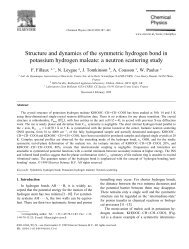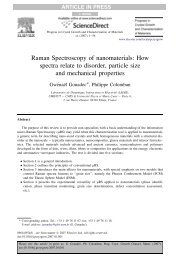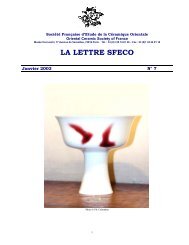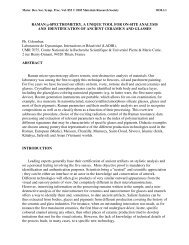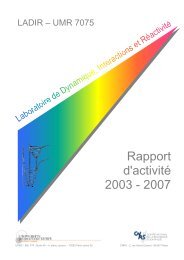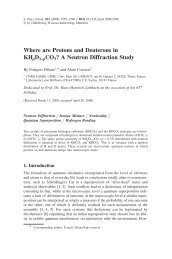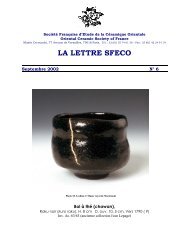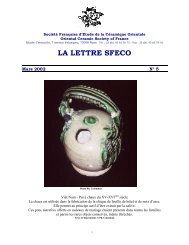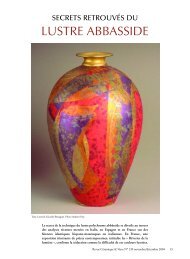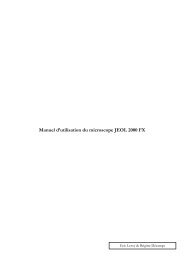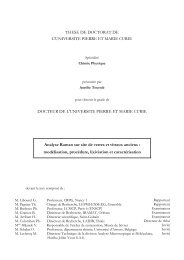12 Nano/microstructure - institut de chimie et des materiaux paris-est
12 Nano/microstructure - institut de chimie et des materiaux paris-est
12 Nano/microstructure - institut de chimie et des materiaux paris-est
- No tags were found...
You also want an ePaper? Increase the reach of your titles
YUMPU automatically turns print PDFs into web optimized ePapers that Google loves.
DK4027_book.fm Page 331 Monday, May 16, 2005 2:01 PM<strong>Nano</strong>/<strong>microstructure</strong> and Multiphase Materials 331properties to be achieved in the different parts of the materials. This work wasma<strong>de</strong> for CeO 2 , an electrolyte for high-temperature fuel cells and its electricalproperties (e.g., the concentration of <strong>de</strong>fects). Raman prediction was in agreementwith electrochemical and thermodynamic measurements. 9,100,101 Prediction of themechanical properties of SiC fibers from Raman spectra is also possible.A mo<strong>de</strong>l has been used to calculate carbon grain size distribution in the asreceivedSA3 cross section (Figure <strong>12</strong>.16c). A ring of larger carbon speciesappears on the fiber’s periphery, indicating a higher short-range or<strong>de</strong>r, which isconsistent with the <strong>de</strong>crease in Raman peak widths. This size increase near thesurface can be linked to the elaboration process, revealing a higher temperaturein this area. Heat-treated fibers show a large increase in this ring. The observedsize distribution indicates that crystal growth of the carbon moi<strong>et</strong>ies is obtaine<strong>de</strong>ven <strong>de</strong>ep in the fiber (a small area of low short-range or<strong>de</strong>r remains at the core).The relationship b<strong>et</strong>ween Raman param<strong>et</strong>ers and mechanical properties allowsconversion of the Raman image in a predictive “mechanical” image. As anexample, we present in Figure <strong>12</strong>.16c the expected ultimate strength to beachieved for the different fiber regions. In this example, the high<strong>est</strong> values areexpected from the fiber core. Other types of fibers exhibit homogeneous behavioror an inverse configuration. Note that if a map gives a didactic view, a line scanoffers a b<strong>et</strong>ter compromise b<strong>et</strong>ween rapidity and quality of information. Anexample is shown in Figure <strong>12</strong>.17 with a line scan (~18 µm) b<strong>et</strong>ween two adjacentNLM SiC fibers in a mullite matrix composite (a ZrO 2 -based coating has beenapplied onto the fibers).200 400 600 800 1000 <strong>12</strong>00 1400 1600 1800Wavenumber / cm −1FIGURE <strong>12</strong>.17 Spectral in-line scan (2 µm step) of a composite cross section. Spectrawere recor<strong>de</strong>d from one NLM202 fiber to another, through the {aluminosilicate + (ZrO 2 ;GeO 2 )} tailored interface and the mullite matrix. (Reprinted from Colomban, P., Ramanmicrospectrom<strong>et</strong>ry and imaging of ceramic fibers in CMCs and MMCs, 103, 517, 2000.With permission from The American Ceramic Soci<strong>et</strong>y.)



